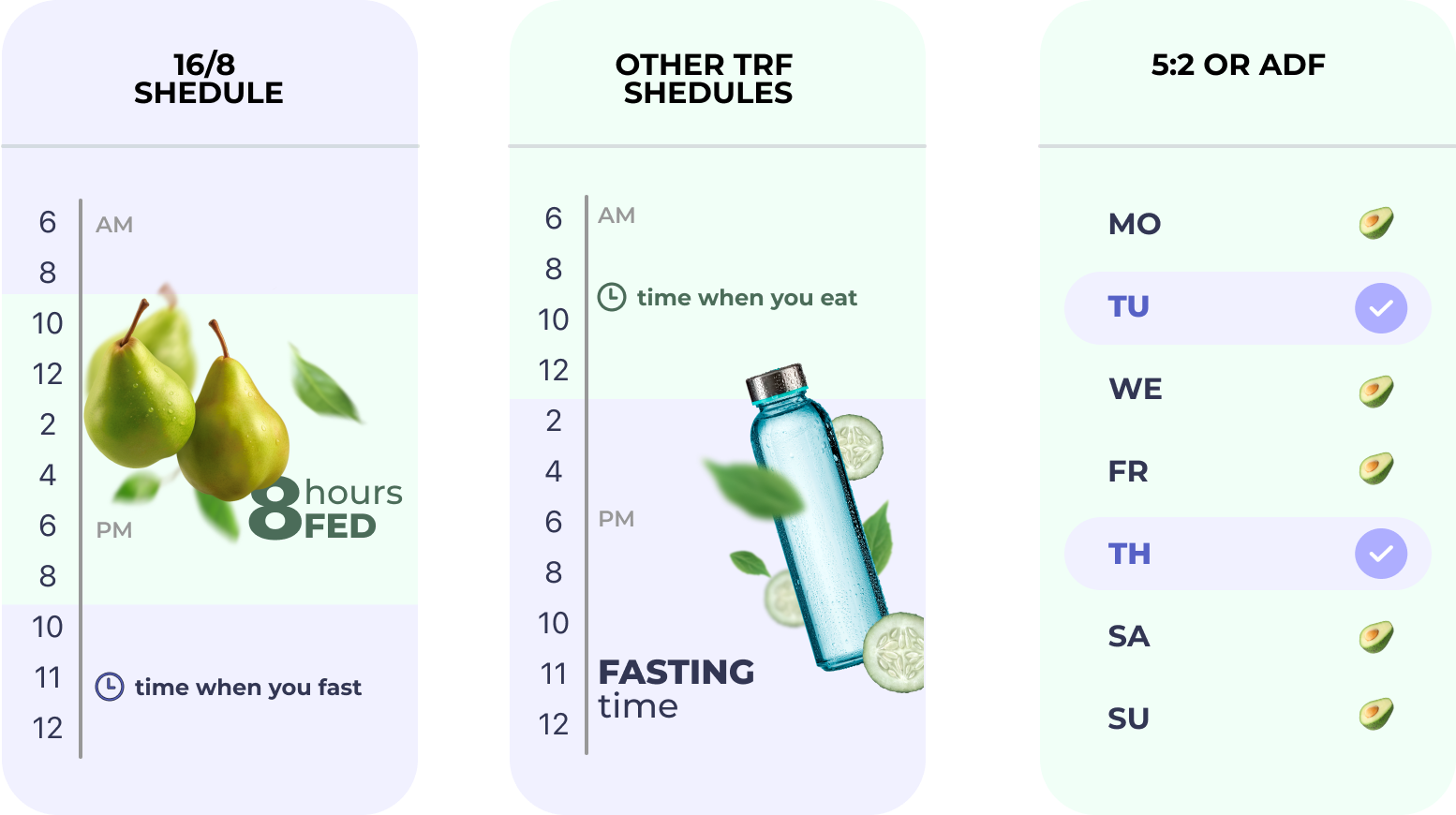The 3 best intermittent fasting schedules to lose belly fat

No matter what algorithms your search history is triggering, you probably can’t go a few clicks through the internet without running into click-bait advertisements for ways to lose belly fat. From intense workouts and restrictive diets to holistic remedies or chemical-heavy supplements, every corner seems to cheer (loudly) for a different solution.
There may be many different strategies out there, but only a few are backed by actual science. Intermittent fasting is one of them.

An eating routine structured around when you eat rather than what you eat, intermittent fasting has been linked to loads of health benefits — like weight loss, reduced inflammation, and lower systolic blood pressure [1,2,3] — in addition to reduced body fat.[4]
When it comes to answering “Does fasting burn belly fat?” it’s a two-part question of
- how intermittent fasting for belly fat works, and
- what fasting to lose belly fat actually looks like.
Spoiler alert: it works and looks a lot like regular intermittent fasting — i.e., it’s exactly the same process, though some schedules and practices may optimize fat burning.
So, what is the best intermittent fasting window to lose belly fat? Let’s get into it.
(If we lost you at “intermittent fasting,” you can brush up on your basics with our intermittent fasting for beginners guide.)

How does intermittent fasting affect belly fat
There are three types of fat in your body — and no, we don’t mean the triple B’s of “belly, booty, and breasts”:
- subcutaneous fat (the stuff under your skin);
- visceral fat (the stuff in your stomach around your vital organs); and
- intramuscular fat (the stuff that’s marbled into your muscles).
All these fats contribute to your health and well-being. You need just the right amount for your unique body — having too little or too much (especially where visceral fat is concerned) could raise your risk of heart disease, metabolic conditions, and certain types of cancer.[5]
Intermittent fasting tackles body fat in two ways:
- Via a calorie deficit. Since intermittent fasting narrows the window where you’re consuming calories, it often leads to a calorie deficit — and eating less calories can reduce fat mass.[6]
- Priming your body for fat burning. If given enough of a break from munching on calories (we’ll cover how long is “enough” shortly!), your body enters a fasted state where it uses fatty acids rather than sugar as fuel (also known as “ketosis”). This process can improve your glucose metabolism and ability to oxidize fat.[6,7]
Unfortunately, intermittent fasting isn’t a magic wand that you can wave over a certain area of your body and say “bibbidi-bobbidi-BYE” to whatever excess fat you may be carrying there. While it can reduce your fat stores, where you lose fat and how long it takes to see results varies from person to person. Plus, intermittent fasting isn’t safe or effective for everyone.
Even though there isn’t an exact, universal “intermittent fasting + belly fat” spell to cast, we’re here as your fairy godparent to help you figure out if intermittent fasting could meet your specific health goals. Pop over to our Simple quiz to learn more about different fasting approaches, decide if intermittent fasting is a good fit for you, and get a personalized plan of action.
Make sure to speak with your healthcare provider before you make any changes to your eating habits or lifestyle, though — they have the big picture view of your health and medical history, so their sign-off is important.
What is the best intermittent fasting schedule to lose belly fat?

Intermittent fasting and belly fat can go hand-in-hand, but how do you know what intermittent fasting schedules are your best bet? If you’re on the hunt for how to fast to lose belly fat, focus on schedules that are most likely to:
a) get you into ketosis (when you start burning fat instead of sugar), and
b) create a calorie deficit.
However, the most important principle to determine what fasting for belly fat should look like is you. Focus on finding the best schedule for your needs, preferences, and lifestyle. Since sustainable results take time, it’s crucial to find a schedule you can stick to without compromising your well-being.
If your healthcare provider has given you the all clear to give intermittent fasting a whirl, here are a few schedules we’d recommend.
Time-restricted eating 16:8
16:8 intermittent fasting — fasting for 16 hours and eating as you wish for 8 hours — is the happy medium of fasting schedules.
Its fasting window is likely long enough to get you into that fasted state (most people take between 12 and 18 hours) and reduce your daily calorie intake (even if you’re eating normally during your eating window, you’ll likely skip a meal or at least reduce snacking).
But it’s also pretty flexible. It simply extends your natural overnight fast. You can choose if you skip breakfast or dinner, and any intermittent fasting side effects are usually short-lived and manageable.
In a study, after 3 months on 16:8, adults with obesity reduced belly fat by 0.2 kg (or about 0.4 lb).[8]

The 5:2 diet or alternate-day fasting
If you’re a fasting pro, you prefer a more on / off fasting schedule, and it’s safe (and bearable) for you to endure a pretty hefty calorie restriction some days, the 5:2 intermittent fasting schedule or alternate day fasting may help you lose some belly fat.
Both of these fasting schedules involve eating as you would normally for some of the week and eating only 500–600 calories on the other days. The 5:2 schedule involves two fasted days of the week. Alternate day fasting involves — you guessed it! — fasting every other day.
Women living with overweight who followed a 5:2 approach for six months lost 4 cm (or 1.5 in.) from their waistline.[9] A similar result was seen in people with type 2 diabetes who followed 5:2 and lost 0.6 kg (or 1.3 lb) after three months.[10]
For alternate-day fasting, short-term studies show that waist circumference decreases by 5–7 cm after 2–3 months,[11,12,13] and longer-term studies demonstrate 0.8 lb (2.7 in.) reductions in belly fat after 12 months.[14]
Some people find the 5:2 diet easier to manage since it’s only two days of calorie counting per week,[15] and there’s some evidence that alternate-day fasting may be superior for fat loss.[16]
Our bottom line when it comes to intermittent fasting is that the best schedule for achieving your goals is one that works for you. Take our Simple quiz to learn about the options and what might be the best intermittent fasting fit given all the things that make you you.
Other time-restricted eating schedules
Depending on your schedule, commitments, and lifestyle, 16:8, 5:2, or alternate-day fasting may not be the ideal balance.
A shorter fasting window (like 12-hour intermittent fasting or 14:10 intermittent fasting) may be a better fit or at least a better starting point. You may be less likely to reach ketosis (it’s slightly more likely with 14:10 [17]), but you’ll still probably be eating less than you normally would since the average person generally eats 15 hours per day.[18]
If you’re an experienced faster, longer fasts (like 18:6 intermittent fasting or 20:4 intermittent fasting) could work, too. However, we don’t recommend fasts for 18+ hours without medical approval / supervision since they’re much more likely to be unsafe, lead to more side effects, and be challenging to manage and sustain.
There isn’t much evidence to suggest “more fasting” means “better results,” either, and the limited research available on these fasting schedules focuses on specific populations, like women with obesity.[19]
Is intermittent fasting a good method for burning belly fat?

Intermittent fasting to lose belly fat may not be a magic wand, but it’s something even better.
Science.
Lots of research supports the idea that intermittent fasting may help you lose not only weight and fat in general,[20] but belly fat specifically (especially in people living with obesity or overweight [21]).[22] One recent review found that people who intermittent fast anywhere from a couple of weeks to a year lost an average of 1.5 lb to almost 25 lb of fat mass.[23] Some research also links intermittent fasting to significant decreases in visceral and subcutaneous fat.[24]
Furthermore, intermittent fasting can be helpful in improving insulin sensitivity and reducing insulin levels.[25,26] Insulin is an important hormone for regulating blood sugar levels,[27] and having too much insulin in your blood or being insulin resistant can lead to increased belly fat.[28]
Although some studies suggest intermittent fasting may not be more effective than simply restricting calories (or may not be effective without other lifestyle changes [29]),[30] others associate fasting with slightly more visceral fat loss.[31]
Now, whether intermittent fasting = visceral fat loss (or any fat loss) for your belly isn’t clear-cut. Things like physical activity, preexisting health conditions, what you eat and drink, and other lifestyle factors can impact your fasting results — and fasting in general impacts people differently. But there are ways you can optimize your fasting experience to make burning belly fat a more likely outcome, and we’ll dive into the what, why, and how of that shortly.
Who is intermittent fasting most effective for?
If fasting affects everyone differently, how do you know if it’ll be effective — and safe — for you?
We always recommend speaking with your healthcare provider before trying intermittent fasting or changing your eating habits. There’s no guarantee that the answer to “Does intermittent fasting burn belly fat?” will be a definitive “yes,” but they’ll tell you if fasting’s even on the table as a potential option.
Also, check in with yourself. Be as realistic as possible. Ditch the theory and aspirations for a moment and ask if intermittent fasting feels like a comfortable fit for your body, needs, preferences, and lifestyle. If you’re looking to lose belly fat but are tired of micro-managing your calorie intake or following strict meal plans, it might be a good time to try intermittent fasting. If you’re someone who needs to eat every few hours or your hunger hulk will emerge, it might be best to give this eating routine a pass.
Intermittent fasting can lead to health benefits, but at Simple, we believe the best and most effective eating routine is one that’s safe, sustainable, and manageable for you. So put yourself at the heart of the process.
Intermittent fasting and losing belly fat for men vs. women
Intermittent fasting for women and intermittent fasting for men work somewhat differently because of how fasting affects hormones and how women’s bodies respond to eating less.
Women’s bodies tend to guard energy sources more rigorously, so sensing a more limited food supply can cause an increase in appetite and decrease the resources available for non-essential body processes.
To make sure everything stays balanced, we recommend women start with a more gradual approach to fasting — so maybe not jumping straight into a 16:8 fasting schedule and definitely not catapulting into 5:2 or alternate day fasting. Especially if you’ve recently finished breastfeeding and are hoping to get rid of “mommy belly,” intermittent fasting is something to ease into as slowly as possible so your body has time to adjust.
Regardless of your sex, intermittent fasting has been linked to fat burning in both women and men who are living with overweight or obesity.[32] Some short-term studies suggest men might lose more visceral fat. It’s about finding a safe, effective fasting schedule that works for your unique body.[33]
10 intermittent fasting tips for burning belly fat

If your healthcare provider has cleared you for intermittent fasting, here are some tips and tricks for making losing belly fat smooth sailing.
1. Start small
You can always build onto your fasting window, but treat your body like a ship: don’t rock the boat too much as you’re testing the waters and getting your sea legs. Gradually easing into fasting allows you to spot any potential waves before they turn into rapids and encourages lasting results. It’s particularly important to pace yourself if your body might be extra sensitive to changes, like if you have health conditions or you’re intermittent fasting for mommy belly.
2. Choose a fasting schedule that works for you
You’re the captain here. If you love going out to dinner, keep your evenings within your eating window. If you tend to work out late morning, don’t skip breakfast.
3. Stay hydrated
Your body is literally made of water, and it needs that water to help burn fat and regulate a whole bunch of body stuff. Water can also help you feel fuller longer and less hungry, plus help you eat less.[34,35] We explain more about it in our guide on what you can drink while fasting.
4. Brace yourself for some bumps
You’re going into uncharted waters here — it’s likely your body will need a minute to adjust. It’s totally normal to experience some growing pains, like headaches, hunger, and fatigue. Rather than abandon ship immediately, keep an eye on them. They may just be signs that you’re moving into deeper waters, not that you’re about to sink.
5. Build in both resistance and cardio training
Combining strength training with intermittent fasting can promote fat loss and lean muscle mass (the latter of which can boost your metabolic rate).[36,37] Cardio can help decrease abdominal fat and waist circumference.[38,39] You can learn more in our guide on exercising during intermittent fasting, but to keep your ship riding the waves, go slowly, start with fewer reps, and give your body time to recover to prevent fatigue and burnout.
6. Prioritize health-promoting food choices
Protein is often linked to lower body fat and more fat oxidization.[40,41] Whole grains are connected to a smaller waist circumference.[42] Fiber from fruits and veggies is associated with reduced belly fat,[43] and healthy fats like nuts and seeds can help you ditch body fat.[44]
Focusing on these foods also helps you get all the nutrients you need (no scurvy in sight!).
7. Eat food you actually enjoy
You’re not stranded on a desert island, so put the luxury of choice to good use and focus on nutrient-dense foods that you enjoy — and don’t skimp on seasoning! Life is too short to waste on bland meals like chicken and steamed broccoli. (Unless, of course, that’s your fave, in which case, enjoy!)
8. Get enough sleep
Sleep is a powerful weight loss tool, and poor sleep may not only increase your appetite but also contribute to weight / fat gain.[45,46] Everyone has different optimal sleep requirements, but we recommend around 7 or more hours a night.[47]
9. Reduce stress
Chronic exposure to cortisol, the hormone produced during periods of stress, is linked to belly fat and enhanced cravings for sweet and fatty foods.[48,49] Especially if you’re trying intermittent fasting for stress belly, make melting that stress iceberg a top priority through techniques like deep breathing, progressive muscle relaxation, or guided visualization.
10. Check in with your body regularly, not obsessively
Constantly taking body measurements or photos is very much giving “watched pot never boils” energy. Keep track of how you feel and the progress you’re making, but be kind to yourself and remember that results take time. You may just not be able to see the shore on the horizon yet.
If you’re concerned that you’ve hit a rock or are stuck in a whirlpool, speak to your healthcare provider or have a look through our intermittent fasting mistakes and intermittent fasting not working troubleshooting guides.
Have more burning questions about how to boost your fat loss? Check out our complete guide to the fastest way to burn fat.

16 hours is the magic number for fasting because it’s often roughly the amount of time it takes for you to achieve ketosis, where the body starts burning fat over sugar as its primary fuel. Bodies react to fasting differently, though, so how long it takes you to reach that stage can be anywhere from around 12 to 18 hours.
How you know you’re burning fat isn’t as simple as stepping on a scale because weight loss and fat loss aren’t the same thing. Take regular measurements of areas where fat gathers (like your waist, arms, shoulders, hips, and legs) and look for reductions. You can take monthly full-body photos and play spot the difference, too.
- Wei X, Cooper A, Lee I, Cernoch CA, Huntoon G, Hodek B, et al. Intermittent Energy Restriction for Weight Loss: A Systematic Review of Cardiometabolic, Inflammatory and Appetite Outcomes. Biol Res Nurs. 2022 Jul;24(3):410–28.
- Wang X, Yang Q, Liao Q, Li M, Zhang P, Santos HO, et al. Effects of intermittent fasting diets on plasma concentrations of inflammatory biomarkers: A systematic review and meta-analysis of randomized controlled trials. Nutrition. 2020 Aug 12;79-80:110974.
- Wang W, Wei R, Pan Q, Guo L. Beneficial effect of time-restricted eating on blood pressure: a systematic meta-analysis and meta-regression analysis. Nutr Metab . 2022 Nov 8;19(1):77.
- Patikorn C, Roubal K, Veettil SK, Chandran V, Pham T, Lee YY, et al. Intermittent Fasting and Obesity-Related Health Outcomes: An Umbrella Review of Meta-analyses of Randomized Clinical Trials. JAMA Netw Open. 2021 Dec 1;4(12):e2139558.
- Silveira EA, Kliemann N, Noll M, Sarrafzadegan N, de Oliveira C. Visceral obesity and incident cancer and cardiovascular disease: An integrative review of the epidemiological evidence. Obes Rev. 2021 Jan;22(1):e13088.
- Cho Y, Hong N, Kim KW, Cho SJ, Lee M, Lee YH, et al. The Effectiveness of Intermittent Fasting to Reduce Body Mass Index and Glucose Metabolism: A Systematic Review and Meta-Analysis. J Clin Med Res [Internet]. 2019 Oct 9;8(10).
- Chiu CH, Chen CH, Wu MH, Lan PT, Hsieh YC, Lin ZY, et al. 5 days of time-restricted feeding increases fat oxidation rate but not affect postprandial lipemia: a crossover trial. Sci Rep. 2022 Jun 3;12(1):9295.
- Gabel K, Hoddy KK, Haggerty N, Song J, Kroeger CM, Trepanowski JF, et al. Effects of 8-hour time restricted feeding on body weight and metabolic disease risk factors in obese adults: A pilot study. Nutr Healthy Aging. 2018 Jun 15;4(4):345–53.
- Harvie MN, Pegington M, Mattson MP, Frystyk J, Dillon B, Evans G, et al. The effects of intermittent or continuous energy restriction on weight loss and metabolic disease risk markers: a randomized trial in young overweight women. Int J Obes. 2011 May;35(5):714–27.
- Carter S, Clifton PM, Keogh JB. The effects of intermittent compared to continuous energy restriction on glycaemic control in type 2 diabetes; a pragmatic pilot trial. Diabetes Res Clin Pract. 2016 Dec;122:106–12.
- Varady KA, Bhutani S, Church EC, Klempel MC. Short-term modified alternate-day fasting: a novel dietary strategy for weight loss and cardioprotection in obese adults. Am J Clin Nutr. 2009 Nov;90(5):1138–43.
- Bhutani S, Klempel MC, Kroeger CM, Trepanowski JF, Varady KA. Alternate day fasting and endurance exercise combine to reduce body weight and favorably alter plasma lipids in obese humans. Obesity. 2013 Jul;21(7):1370–9.
- Eshghinia S, Mohammadzadeh F. The effects of modified alternate-day fasting diet on weight loss and CAD risk factors in overweight and obese women. J Diabetes Metab Disord. 2013 Jan 9;12(1):4.
- Trepanowski JF, Kroeger CM, Barnosky A, Klempel MC, Bhutani S, Hoddy KK, et al. Effect of Alternate-Day Fasting on Weight Loss, Weight Maintenance, and Cardioprotection Among Metabolically Healthy Obese Adults: A Randomized Clinical Trial. JAMA Intern Med. 2017 Jul 1;177(7):930–8.
- Hajek P, Przulj D, Pesola F, McRobbie H, Peerbux S, Phillips-Waller A, et al. A randomised controlled trial of the 5:2 diet. PLoS One. 2021 Nov 17;16(11):e0258853.
- Alhamdan BA, Garcia-Alvarez A, Alzahrnai AH, Karanxha J, Stretchberry DR, Contrera KJ, et al. Alternate-day versus daily energy restriction diets: which is more effective for weight loss? A systematic review and meta-analysis. Obes Sci Pract. 2016 Sep;2(3):293–302.
- Peeke PM, Greenway FL, Billes SK, Zhang D, Fujioka K. Effect of time restricted eating on body weight and fasting glucose in participants with obesity: results of a randomized, controlled, virtual clinical trial. Nutr Diabetes. 2021 Jan 15;11(1):6.
- Gill S, Panda S. A Smartphone App Reveals Erratic Diurnal Eating Patterns in Humans that Can Be Modulated for Health Benefits. Cell Metab. 2015 Nov 3;22(5):789–98.
- Cienfuegos S, Gabel K, Kalam F, Ezpeleta M, Lin S, Varady KA. Changes in body weight and metabolic risk during time restricted feeding in premenopausal versus postmenopausal women. Exp Gerontol. 2021 Oct 15;154:111545.
- Gu L, Fu R, Hong J, Ni H, Yu K, Lou H. Effects of Intermittent Fasting in Human Compared to a Non-intervention Diet and Caloric Restriction: A Meta-Analysis of Randomized Controlled Trials. Front Nutr. 2022 May 2;9:871682.
- Morales-Suarez-Varela M, Collado Sánchez E, Peraita-Costa I, Llopis-Morales A, Soriano JM. Intermittent Fasting and the Possible Benefits in Obesity, Diabetes, and Multiple Sclerosis: A Systematic Review of Randomized Clinical Trials. Nutrients [Internet]. 2021 Sep 13;13(9).
- Yang F, Liu C, Liu X, Pan X, Li X, Tian L, et al. Effect of Epidemic Intermittent Fasting on Cardiometabolic Risk Factors: A Systematic Review and Meta-Analysis of Randomized Controlled Trials. Front Nutr. 2021 Oct 18;8:669325.
- Santos HO. Intermittent Fasting and Fat Mass: What Is the Clinical Magnitude? Obesities. 2022 Jan 7;2(1):1–7.
- Abdallah H, Khalil M, Farella I, JohnBritto JS, Lanza E, Santoro S, et al. Ramadan intermittent fasting reduces visceral fat and improves gastrointestinal motility. Eur J Clin Invest [Internet]. 2023 May 19.
- Yuan X, Wang J, Yang S, Gao M, Cao L, Li X, et al. Effect of Intermittent Fasting Diet on Glucose and Lipid Metabolism and Insulin Resistance in Patients with Impaired Glucose and Lipid Metabolism: A Systematic Review and Meta-Analysis. Int J Endocrinol. 2022 Mar 24;2022:6999907.
- Albosta M, Bakke J. Intermittent fasting: is there a role in the treatment of diabetes? A review of the literature and guide for primary care physicians. Clin Diabetes Endocrinol. 2021 Feb 3;7(1):3.
- Rahman MS, Hossain KS, Das S, Kundu S, Adegoke EO, Rahman MA, et al. Role of Insulin in Health and Disease: An Update. Int J Mol Sci [Internet]. 2021 Jun 15;22(12).
- Verkouter I, Noordam R, le Cessie S, van Dam RM, Lamb HJ, Rosendaal FR, et al. The Association between Adult Weight Gain and Insulin Resistance at Middle Age: Mediation by Visceral Fat and Liver Fat. J Clin Med Res [Internet]. 2019 Sep 28;8(10).
- Lowe DA, Wu N, Rohdin-Bibby L, Moore AH, Kelly N, Liu YE, et al. Effects of Time-Restricted Eating on Weight Loss and Other Metabolic Parameters in Women and Men With Overweight and Obesity: The TREAT Randomized Clinical Trial. JAMA Intern Med. 2020 Nov 1;180(11):1491–9.
- Seimon RV, Roekenes JA, Zibellini J, Zhu B, Gibson AA, Hills AP, et al. Do intermittent diets provide physiological benefits over continuous diets for weight loss? A systematic review of clinical trials. Mol Cell Endocrinol. 2015 Dec 15;418 Pt 2:153–72.
- Arciero PJ, Poe M, Mohr AE, Ives SJ, Arciero A, Sweazea KL, et al. Intermittent fasting and protein pacing are superior to caloric restriction for weight and visceral fat loss. Obesity . 2023 Feb;31 Suppl 1(Suppl 1):139–49.
- Elortegui Pascual P, Rolands MR, Eldridge AL, Kassis A, Mainardi F, Lê KA, et al. A meta-analysis comparing the effectiveness of alternate day fasting, the 5:2 diet, and time-restricted eating for weight loss. Obesity. 2023 Feb;31 Suppl 1(Suppl 1):9–21.
- Domaszewski P, Konieczny M, Dybek T, Łukaniszyn-Domaszewska K, Anton S, Sadowska-Krępa E, et al. Comparison of the effects of six-week time-restricted eating on weight loss, body composition, and visceral fat in overweight older men and women. Exp Gerontol. 2023 Apr;174:112116.
- Dennis EA, Dengo AL, Comber DL, Flack KD, Savla J, Davy KP, et al. Water consumption increases weight loss during a hypocaloric diet intervention in middle-aged and older adults. Obesity. 2010 Feb;18(2):300–7.
- Corney RA, Sunderland C, James LJ. Immediate pre-meal water ingestion decreases voluntary food intake in lean young males. Eur J Nutr. 2016 Mar;55(2):815–9.
- Keenan S, Cooke MB, Belski R. The Effects of Intermittent Fasting Combined with Resistance Training on Lean Body Mass: A Systematic Review of Human Studies. Nutrients [Internet]. 2020 Aug 6;12(8).
- Westcott WL. Resistance training is medicine: effects of strength training on health. Curr Sports Med Rep. 2012 Jul-Aug;11(4):209–16.
- Alberga AS, Prud’homme D, Kenny GP, Goldfield GS, Hadjiyannakis S, Gougeon R, et al. Effects of aerobic and resistance training on abdominal fat, apolipoproteins and high-sensitivity C-reactive protein in adolescents with obesity: the HEARTY randomized clinical trial. Int J Obes . 2015 Oct;39(10):1494–500.
- Lemes ÍR, Turi-Lynch BC, Cavero-Redondo I, Linares SN, Monteiro HL. Aerobic training reduces blood pressure and waist circumference and increases HDL-c in metabolic syndrome: a systematic review and meta-analysis of randomized controlled trials. J Am Soc Hypertens. 2018 Aug;12(8):580–8.
- Simonson M, Boirie Y, Guillet C. Protein, amino acids and obesity treatment. Rev Endocr Metab Disord. 2020 Sep;21(3):341–53.
- Home Page: The American Journal of Clinical Nutrition [Internet]. [cited 2023 Jul 27].
- McRae MP. Health Benefits of Dietary Whole Grains: An Umbrella Review of Meta-analyses. J Chiropr Med. 2017 Mar;16(1):10–8.
- Jovanovski E, Mazhar N, Komishon A, Khayyat R, Li D, Blanco Mejia S, et al. Can dietary viscous fiber affect body weight independently of an energy-restrictive diet? A systematic review and meta-analysis of randomized controlled trials. Am J Clin Nutr. 2020 Feb 1;111(2):471–85.
- Lotfi K, Saneei P, Hajhashemy Z, Esmaillzadeh A. Adherence to the Mediterranean Diet, Five-Year Weight Change, and Risk of Overweight and Obesity: A Systematic Review and Dose-Response Meta-Analysis of Prospective Cohort Studies. Adv Nutr. 2022 Feb 1;13(1):152–66.
- Papatriantafyllou E, Efthymiou D, Zoumbaneas E, Popescu CA, Vassilopoulou E. Sleep Deprivation: Effects on Weight Loss and Weight Loss Maintenance. Nutrients [Internet]. 2022 Apr 8;14(8).
- Capers PL, Fobian AD, Kaiser KA, Borah R, Allison DB. A systematic review and meta-analysis of randomized controlled trials of the impact of sleep duration on adiposity and components of energy balance. Obes Rev. 2015 Sep;16(9):771–82.
- Watson NF, Badr MS, Belenky G, Bliwise DL, Buxton OM, Buysse D, et al. Recommended Amount of Sleep for a Healthy Adult: A Joint Consensus Statement of the American Academy of Sleep Medicine and Sleep Research Society. Sleep. 2015 Jun 1;38(6):843–4.
- van der Valk ES, Savas M, van Rossum EFC. Stress and Obesity: Are There More Susceptible Individuals? Curr Obes Rep. 2018 Jun;7(2):193–203.
- Xiao Y, Liu D, Cline MA, Gilbert ER. Chronic stress, epigenetics, and adipose tissue metabolism in the obese state. Nutr Metab. 2020 Oct 19;17:88.
